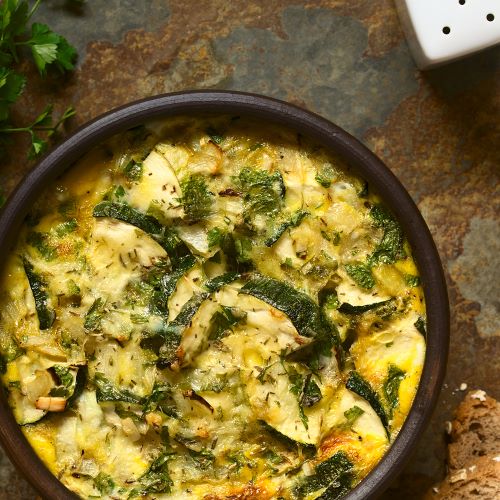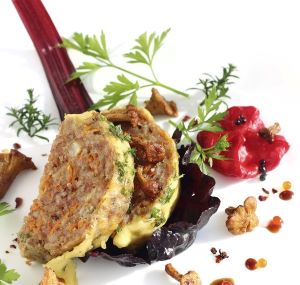Kcal: 610 Proteins: 21 Fat: 51 Net Carbs: 16
Click to get more Easy, Healthy Recipes
Preparation Time
20 minutesBaking Time
0 minutesDifficulty Rating
1Health Level
4Serves
3

Ingredients
- Heavy Cream, 0.5 cup (117 g)
- Butter, No Salt, 2 tablespoon (28 g)
- Sausage, smoked link sausage, pork and beef, 10.5 oz (298 g)
- Chicken Stock, 3 cups (729 g)
- Onion, Fresh, 1 small (70 g)
- Garlic, 3 garlic clove (12 g)
- Spinach, 6 cups (174 g)
- Celery, 1 stalk, small (5" long) (17 g)
- Table salt, 1/3 teaspoon (1 g)
- Black Pepper, 1/3 tsp (1 g)
- Fresh Basil, 1 tablespoons (3 g)
Instructions
- Chop garlic, onion and celery.
- Heat the butter in a pan. Add the sausage, garlic, celery, pepper and onion and cook for 7-8 minutes until the sausage is starting to brown, stirring.
- Add the chicken stock and bring up to a boil; cover the pan and cook 5 minutes.
- Add the spinach and cook, stirring constantly, for 3-4 minutes.
- Turn off the heat and stir in the heavy cream.
Comments 17
Leave a Reply
You must be logged in to post a comment.




I don’t like celery, what can I substitute for it?
Hi, Candylm. Any seasoning (herb or spice) or non-starchy vegetable or similar item (like zucchini/courgette or mushrooms) of your choice will do.
So delicious. I used half spinach and half kale. I was running out of spinach. I hope this is ok.
Hi, Evaluna. More than OK – that sounds great!
Am I missing the serving sizes if not making just one portion?
Hi, MrsFrench. Apologies – I don’t quite understand your question. Are you asking about making and eating less than a single portion?
I do not eat sausage, just wondering what could be substituted?
Hi, k979904. Any fatty meat will do.
Should my carb grams be this high for one day? I thought I was not suppose to have more than 25 grams to stay in ketosis
Hi, Leigh0712. What makes an item or menu keto-supportive is if it has the same or more grams of fat compared to the combination of carbohydrate+protein. This plan provides recipes and menus that always have a 1:1 ratio, and often nearly twice that. The carbohydrates here largely fibers are from fruits and vegetables, which are vital components of any healthy eating plan. In general, it is recommended for diabetes to get about 45% or less of their energy from carbohydrates (compared to up to 70% on a “regular” diet), and even our non-keto route provides that.
Thank you. So I had the shrimp stuffed avacado for breakfast and 4 keto stuffed mushrooms for lunch. And I became really Hungary 2 hours after lunch. Is that normal, I thought the keto diet would keep me full longer .
Hi, Leigh0712. Different food properties work differently for different people. It appears you are the type who would respond best to higher volume. This means more fluids and fiber. Drinking water (or water-containing beverages) or having clear soup before and between meals can help with this. It can also help to add a light salad (with low-carbohydrate vegetables such as lettuce and other raw greens, cucumbers, celery, turnips, kohlrabi) to meals, as a second course after the soup and before the main item; you can season the salad with lemon juice and garlic powder.
I am not able to make it home for dinner , can I replace my meal with hard boiled eggs and how many?
Hi, Leigh0712. Hard boiled eggs don’t yield enough energy to really use them alone to replace a meal, and usually three is the limit for most people. Most grocery stores have keto meal options these days – if you don’t have access to a microwave oven, even just 6 tablespoons of nut butter (like peanut or almond) plus 5 medium stalks of celery (or 2 cups pre-cut) would be an excellent option; you can use half those amounts if you also want the eggs. If you want to dine out, try this guide:
• If you can, get online to search for the ideal place ahead of time, filtering the options by features. Look for restaurants with an emphasis on whole foods, including vegetables and even ‘slow’ cooking – or at least a de-emphasis on junk food.
• If you know in advance where you’re going, peruse the menu ahead of time and prepare yourself with the right choices. The usual wisdom applies here: salads, cooked or ‘hidden’ vegetables (i.e. red sauce and salsa), use of nuts and seeds, high-fat cuts of meat, fatty fish, heavy sauces, and creamy desserts. Or if nothing else, “prepared how you like it”.
• Avoid the bread or chip basket, or any other high-carbohydrate filler that a restaurant may offer before a meal. This will add a whole new course that you hadn’t anticipated, highly likely to de-keto the entire meal. This can be diet sabotage, so kindly ask the server in advance to leave the breadbasket or chips and salsa off your table, so you are not tempted. If you order unsweetened tea or water with lemon in advance for sipping, you may not miss it. When it comes to the real food, eat bulky foods first, generally high in water and fiber – order a salad with dressing or cream soup as your first course, and when dinner arrives, start with the lightest foods on your plate, usually the vegetables (be sure to ask for butter if it wasn’t added automatically).
• Don’t be shy about asking how your food is prepared. They are there to serve customers, of which you are one. Even if your server doesn’t know, the cook does, and if you do, you can take it or leave it – or improve it. Find out if butter, margarine, or oil is used, and if you can get it added. Ask about the sauce that comes with an entrée, and if it has “cream”, “butter”, or “cheese” at the core – this is from where the keto advantage comes.
• Look for foods on the menu that are broiled or grilled (but not charred or blackened), creamy, creamed, au gratin, or escalloped – all of which are synonyms for high amounts of added fat. Avoid anything breaded or deep fried, as carbohydrates are likely to be high there.
• For side dishes, be sure to get the lowest-carbohydrate option. This is usually a vegetable that can be served with butter, a cream sauce, or high-fat dressing.
• When ordering salad, be sure to get a high-fat, low-carbohydrate, minimally processed option. Avoid “French” and “Russian” dressings, and anything with “honey” or “maple” in the name (high in sugar). Ask if the dressings are homemade – this is preferable over anything bottled. The safest and healthiest bet is generally oil and vinegar or lemon.
• When options or substitutions can be made, the following are some common keto-friendly, healthy choices you can make at different types of restaurants:
– At a pizzeria, choose the cauliflower crust (or keto option, if they have it). Note that when it comes to toppings other than cheese, olives are highest in fat, and artichokes and pineapple are highest in carbohydrates. Avoid highly processed meat choices such as salami, ham, pepperoni, etc., unless they are homemade and uncured – industrially ultra-processed choices may be high in fat, but they won’t do your health any favors.
– In an Italian restaurant, if you like meats, chicken, or eggplant, try the “Parmesan” types or those labeled “smothered.” Order pasta creamy white or butter sauces as Alfredo, and avoid the red sauce unless it is made with a lot of high-fat additives such as olive oil or olives, and you plan on piling on the Parmesan as your main entrée.
– A French restaurant is generally a keto-lover’s paradise – items are more often than not drenched in butter, cream, and cheese – but be sure to follow the principles described elsewhere in this list. Sauces are often made with flour, but the amount is generally much lower than the fat added. Do avoid the bread and pastries unless there is specifically a keto type offered.
– Eastern European restaurants tend to offer high-fat fare, but beware the great commonality of high-carbohydrate accompaniments such as bread, dumplings, pancakes, and potatoes.
– In an Asian restaurant, choose fried rice instead of plain steamed – brown if you can get it. Look for rich sauces and coatings such as peanut, coconut, and butter. Choose higher-fat options among meat, fish, and poultry – for example, white beef, white tuna, salmon, salmon skin, and duck (especially if domestic). Choose low-sugar dishes – avoid anything labeled “sweet,” “honey,” “teriyaki,” “breaded,” and select those with vegetables and nuts rather than fruit (other than coconut, of course). Beware of high-carbohydrate encased items such as tempura, egg rolls, wonton, and dumplings. Be sure to avoid monosodium glutamate (MSG), which can work against your weight and health goals. Have a salad with dressing or creamy soup as a first course.
– In a Mexican restaurant, it goes without saying to avoid tortilla chips and tortillas and high-carbohydrate shells in general. Lettuce leaves make for excellent wraps, and you may even find a keto option that provides an experience closer to the traditional. Choose sour cream, cheese, avocado, and olives as toppings. Salsa and pico de gallo are great sources of vegetables, but go easy on them, as they can push your meal into non-keto territory. Choose refried beans instead of baked.
– For dessert at any restaurant, seek on the menu or inquire about low-carbohydrate options. Check into a low-sugar ice cream, or if you can order minimally or unsweetened whipped cream and/or nuts over fruit for dessert. In general, it is best to split desserts with your companion(s) – just a taste will do. You can always order coffee or tea with cream and low-carbohydrate sweetener to make up for it.
– In a cafeteria or buffet-style restaurant, be sure to keep in mind all of the above principles and the “keys” below, no matter what type of food is being served. Choose just your favorites among the options, pace yourself with regard to amounts – just a tablespoon or two of each item if there is a lot – and avoid going back for seconds!
• Balance is key. If you really want a high-calorie item, balance it out with lighter choices for the rest of the meal.
• Portion size is key. Take a look at your Trim Down Club menu to get a sense of how much you should be eating for the meal.
• Control is key. Sticking with sound serving sizes can sometimes be easier said than done. Many restaurants, especially the ‘affordable’ ones, make it a point to fill your plate to give you a sense of value. Though this seems like a good idea, be aware that it can take up nearly your entire daily allotment for calories. Cut your ‘gains’ right away, and divide your restaurant portion into two – share with a dining partner, or just eat half there and pack the other half to go – in this way, you avoid the problem of eating too much and paying for it later. If you know you’ll be tempted to eat more than you should, ask to have your ‘doggy bag’ prepared in advance, so you’ll only get a sensible portion size at the table. Some restaurants will even let you buy a half order or children’s portion of an entrée.
When I made this, I used fresh kale in place of the spinach. It is a nice filling soup, even better the next day.
Hi, MedHatter. No, I think that may have just been a glitch. It has been corrected.
Step 3 and 6 are the same.. are we only using half the chicken stock each time?